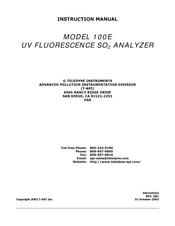Teledyne 100E Manuals
Manuals and User Guides for Teledyne 100E. We have 3 Teledyne 100E manuals available for free PDF download: Instruction Manual, Training Manual
Teledyne 100E Instruction Manual (308 pages)
UV FLUORESCENCE SO2 ANALYZER
Brand: Teledyne
|
Category: Measuring Instruments
|
Size: 7 MB
Table of Contents
-
Warranty21
-
Startup35
-
Warm-Up36
-
Faq's43
-
Glossary44
-
Mode Field57
-
Sample Mode58
-
Setup Mode64
-
Range Units74
-
Signal I/O80
-
Optic Test93
-
Analyzer ID99
-
Parity: None100
-
Subnet Mask105
-
COM Port Testing115
-
Led State116
-
Idas Structure117
-
Idas Channels117
-
Idas Parameters118
-
Trigger Events123
-
Report Function129
-
Compact Report129
-
Starting Date129
-
HOLDOFF Feature131
-
Status Outputs134
-
Control Inputs135
-
VDC Power136
-
Command Syntax138
-
Data Types138
-
Status Reporting139
-
Security Mode141
-
Mode Description146
-
Warning Flags147
-
Zero Air151
-
Permeation Tubes152
-
Calibration Gas152
-
SAMPLE Gas156
-
Record Keeping170
-
Precision Check173
-
References175
-
UV Source Lamp188
-
The PMT189
-
Optical Filters190
-
Optical Lenses191
-
Dilution193
-
Light Pollution193
-
Sample Gas Flow194
-
Cpu200
-
Disk on Chip200
-
Flash Chip201
-
Sensor Module201
-
Sample Chamber202
-
PMT Preamplifier206
-
Relay Board207
-
Heater Control207
-
Valve Control207
-
Motherboard209
-
Sensor Inputs209
-
Analog Outputs210
-
I 2 C da Ta Bus211
-
Power up Circuit211
-
Keyboard214
-
Display215
-
Adaptive Filter218
-
Warning Messages222
-
Status Leds227
-
High Flow229
-
No Response230
-
Excessive Noise233
-
Slow Response233
-
DC Power Supply239
-
I 1 C Bus240
-
Relay Board241
-
Motherboard241
-
A/D Functions241
-
Status Outputs242
-
Control Inputs243
-
Cpu243
-
Communication244
-
Shutter System245
-
PMT Sensor245
-
Sample Pressure247
-
IZS Option248
-
Box Temperature248
-
PMT Temperature248
Advertisement
Teledyne 100E Instruction Manual (258 pages)
UV FLUORESCENCE SO2 ANALYZER
Brand: Teledyne
|
Category: Measuring Instruments
|
Size: 3 MB
Table of Contents
-
-
Warranty23
-
Startup38
-
Warm-Up39
-
Faq's47
-
Glossary48
-
Sample Mode58
-
Setup Mode61
-
Clock (CLK)64
-
Range Units71
-
Signal I/O76
-
Optic Test87
-
Analyzer ID95
-
COM Port Testing101
-
Idas Channels105
-
Idas Structure105
-
Idas Parameters106
-
Trigger Events111
-
Compact Report117
-
Report Function117
-
Starting Date117
-
HOLDOFF Feature118
-
Basic Operation121
-
Command Syntax121
-
Data Types122
-
Status Reporting123
-
Gas Standards129
-
Zero Air129
-
Permeation Tubes130
-
Record Keeping148
-
Precision Check153
-
References154
-
UV Source Lamp168
-
Optical Filters169
-
The PMT169
-
Optical Lenses171
-
Dilution173
-
Light Pollution173
-
Sample Gas Flow174
-
Cpu179
-
Disk on Chip180
-
Flash Chip180
-
PMT Preamplifier184
-
Heater Control186
-
Relay Board186
-
Valve Control186
-
Motherboard188
-
Sensor Inputs188
-
Analog Outputs189
-
I C Data Bus190
-
Power up Circuit190
-
Keyboard193
-
Display194
-
Adaptive Filter196
-
Warning Messages200
-
Status Leds203
-
High Flow206
-
Sample Flow206
-
Zero or Low Flow206
-
No Response207
-
Excessive Noise210
-
Slow Response210
-
DC Power Supply212
-
I C Bus213
-
Relay Board214
-
A/D Functions215
-
Motherboard215
-
Control Inputs216
-
Status Outputs216
-
Communication217
-
Cpu217
-
PMT Sensor218
-
IZS Option219
-
Sample Pressure219
-
Box Temperature220
-
PMT Temperature220
Teledyne 100E Training Manual (102 pages)
UV FLUORESCENCE SO2 ANALYZER
Brand: Teledyne
|
Category: Measuring Instruments
|
Size: 4 MB
Table of Contents
-
User Notes14
-
Maintenance40
-
User Notes42
-
User Notes61
-
Optic Test69
-
Front Panel88
-
Rear Panel93
Advertisement
Advertisement


